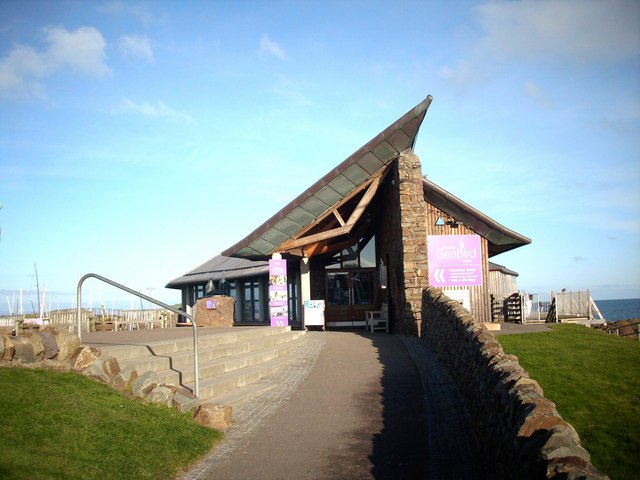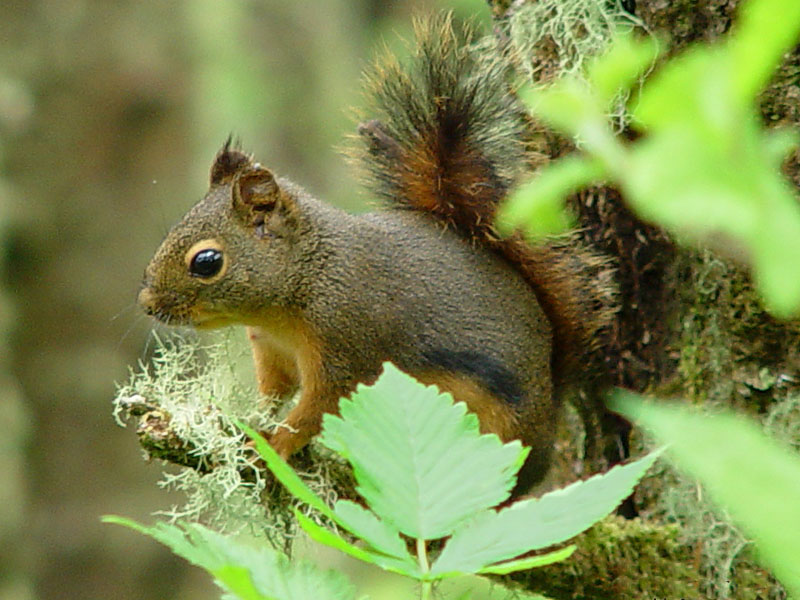|
Scottish Seabird Centre
The Scottish Seabird Centre is a marine conservation and education charity, that is supported by an award-winning visitor attraction in North Berwick, East Lothian, Scotland. Opened by the Duke of Rothesay in 2000 and funded by the Millennium Commission. The showpiece of the centre is the interactive live cameras out to the wildlife on the Firth of Forth islands, including Bass Rock, Isle of May, Fidra and Craigleith. The Bass Rock is the world's largest colony of Northern gannets with an estimated 150,000 birds present. History Materials used to construct the centre were, whenever possible, environmentally sustainable and locally sourced. The centre was designed by Edinburgh architects Simpson & Brown to make use of natural light and ventilation, and to offer panoramic views both to sea and inland towards North Berwick Law. Very little plastic was used in construction, with wood, stone and metal being preferred. The site now occupied by the Scottish Seabird Centre once over ... [...More Info...] [...Related Items...] OR: [Wikipedia] [Google] [Baidu] |
Marine Conservation
Marine conservation, also known as ocean conservation, is the protection and preservation of ecosystems in oceans and seas through planned management in order to prevent the over-exploitation of these marine resources. Marine conservation is informed by the study of marine plants and animal resources and ecosystem functions and is driven by response to the manifested negative effects seen in the environment such as species loss, habitat degradation and changes in ecosystem functions and focuses on limiting human-caused damage to marine ecosystems, restoring damaged marine ecosystems, and preserving vulnerable species and ecosystems of the marine life. Marine conservation is a relatively new discipline which has developed as a response to biological issues such as extinction and marine habitats change. Marine conservationists rely on a combination of scientific principles derived from marine biology, Ecology, oceanography, and fisheries science, as well as on human factors ... [...More Info...] [...Related Items...] OR: [Wikipedia] [Google] [Baidu] |
Bass Rock
The Bass Rock, or simply the Bass (), is an island in the outer part of the Firth of Forth in the east of Scotland. Approximately offshore, and north-east of North Berwick, it is a steep-sided volcanic plug, at its highest point, and is home to a large colony of gannets. The rock is uninhabited, but historically has been settled by an 8th-century Christian hermit, and later was the site of an important castle, which after the Commonwealth period was used as a prison. The island belongs to Hew Hamilton-Dalrymple, whose family acquired it in 1706, and previously to the Lauder family for almost six centuries. The Bass Rock Lighthouse was constructed on the rock in 1902, and the remains of a chapel survive. The Bass Rock features in many works of fiction, including Lion Let Loose by Nigel Tranter, ''Catriona'' by Robert Louis Stevenson, ''The Lion Is Rampant'' by the Scottish novelist Ross Laidlaw and ''The New Confessions'' by William Boyd. Most recently it features prom ... [...More Info...] [...Related Items...] OR: [Wikipedia] [Google] [Baidu] |
Protected Areas Of East Lothian
Protection is any measure taken to guard something against damage caused by outside forces. Protection can be provided to physical objects, including organisms, to systems, and to intangible things like civil and political rights. Although the mechanisms for providing protection vary widely, the basic meaning of the term remains the same. This is illustrated by an explanation found in a manual on electrical wiring: Some kind of protection is a characteristic of all life, as living things have evolved at least some protective mechanisms to counter damaging environmental phenomena, such as ultraviolet light. Biological membranes such as bark on trees and skin on animals offer protection from various threats, with skin playing a key role in protecting organisms against pathogens and excessive water loss. Additional structures like scales and hair offer further protection from the elements and from predators, with some animals having features such as spines or camouflage servi ... [...More Info...] [...Related Items...] OR: [Wikipedia] [Google] [Baidu] |
Tourist Attractions In East Lothian
Tourism is travel for pleasure, and the Commerce, commercial activity of providing and supporting such travel. World Tourism Organization, UN Tourism defines tourism more generally, in terms which go "beyond the common perception of tourism as being limited to holiday activity only", as people "travelling to and staying in places outside their usual environment for not more than one consecutive year for leisure and not less than 24 hours, business and other purposes". Tourism can be Domestic tourism, domestic (within the traveller's own country) or International tourism, international. International tourism has both incoming and outgoing implications on a country's balance of payments. Between the second half of 2008 and the end of 2009, tourism numbers declined due to a severe Economy, economic slowdown (see Great Recession) and the outbreak of the 2009 2009 flu pandemic, H1N1 influenza virus. These numbers, however, recovered until the COVID-19 pandemic put an abrupt end to th ... [...More Info...] [...Related Items...] OR: [Wikipedia] [Google] [Baidu] |
Wildlife Rehabilitation And Conservation Centers
Wildlife refers to undomesticated animals and uncultivated plant species which can exist in their natural habitat, but has come to include all organisms that grow or live wild in an area without being introduced by humans. Wildlife was also synonymous to game: those birds and mammals that were hunted for sport. Wildlife can be found in all ecosystems. Deserts, plains, grasslands, woodlands, forests, and other areas including the most developed urban areas, all have distinct forms of wildlife. While the term in popular culture usually refers to animals that are untouched by human factors, most scientists agree that much wildlife is affected by human activities. Some wildlife threaten human safety, health, property and quality of life. However, many wild animals, even the dangerous ones, have value to human beings. This value might be economic, educational, or emotional in nature. Humans have historically tended to separate civilization from wildlife in a number of ways, incl ... [...More Info...] [...Related Items...] OR: [Wikipedia] [Google] [Baidu] |
Nature Centres In Scotland
Nature is an inherent character or constitution, particularly of the ecosphere or the universe as a whole. In this general sense nature refers to the laws, elements and phenomena of the physical world, including life. Although humans are part of nature, human activity or humans as a whole are often described as at times at odds, or outright separate and even superior to nature. During the advent of modern scientific method in the last several centuries, nature became the passive reality, organized and moved by divine laws. With the Industrial Revolution, nature increasingly became seen as the part of reality deprived from intentional intervention: it was hence considered as sacred by some traditions (Rousseau, American transcendentalism) or a mere decorum for divine providence or human history (Hegel, Marx). However, a vitalist vision of nature, closer to the pre-Socratic one, got reborn at the same time, especially after Charles Darwin. Within the various uses of the word t ... [...More Info...] [...Related Items...] OR: [Wikipedia] [Google] [Baidu] |
Buildings And Structures In East Lothian
A building or edifice is an enclosed structure with a roof, walls and windows, usually standing permanently in one place, such as a house or factory. Buildings come in a variety of sizes, shapes, and functions, and have been adapted throughout history for numerous factors, from building materials available, to weather conditions, land prices, ground conditions, specific uses, prestige, and aesthetic reasons. To better understand the concept, see ''Nonbuilding structure'' for contrast. Buildings serve several societal needs – occupancy, primarily as shelter from weather, security, living space, privacy, to store belongings, and to comfortably live and work. A building as a shelter represents a physical separation of the human habitat (a place of comfort and safety) from the ''outside'' (a place that may be harsh and harmful at times). buildings have been objects or canvasses of much artistic expression. In recent years, interest in sustainable planning and building practi ... [...More Info...] [...Related Items...] OR: [Wikipedia] [Google] [Baidu] |
Joseph Bryan Nelson
Joseph Bryan Nelson MBE FRSE (14 March 1932 – 29 June 2015) was a British ornithologist, environmental activist and academic. He was a prominent authority on seabirds, publishing numerous books and articles on gannets, cormorants and other species, teaching zoology at the University of Aberdeen, and conducting pioneering ornithological research in Jordan, Christmas Island and the Galápagos Islands. Nelson was "acclaimed as the world's leading expert on the northern gannet". He also contributed to the creation of Christmas Island National Park, which helped to preserve the habitat of the endangered Abbott's booby. Early life and education Nelson was born in Shipley, West Yorkshire in 1932, the third of four children of a motor engineer and a draper. For most of his life, he was known by his middle name, Bryan. As a child during World War II, he developed a fascination with birds after he was given a book on ornithology. He attended a grammar school in the town of ... [...More Info...] [...Related Items...] OR: [Wikipedia] [Google] [Baidu] |
Prince Philip
Prince Philip, Duke of Edinburgh (born Prince Philip of Greece and Denmark, later Philip Mountbatten; 10 June 19219 April 2021), was the husband of Queen Elizabeth II. As such, he was the consort of the British monarch from his wife's accession on 6 February 1952 until Death and funeral of Prince Philip, Duke of Edinburgh, his death in 2021, making him the longest-serving royal consort in history. Philip was born in Greece into the Greek royal family, Greek and Danish royal family, Danish royal families; his family was exiled from the country when he was eighteen months old. After being educated in France, Germany, and the United Kingdom, he joined the Royal Navy in 1939, when he was 18 years old. In July 1939, Philip began corresponding with the 13-year-old Princess Elizabeth, the elder daughter and heir presumptive of King George VI. During the Second World War, he served with distinction in the British Mediterranean Fleet, Mediterranean and Britis ... [...More Info...] [...Related Items...] OR: [Wikipedia] [Google] [Baidu] |
Queen Elizabeth II
Elizabeth II (Elizabeth Alexandra Mary; 21 April 19268 September 2022) was Queen of the United Kingdom and other Commonwealth realms from 6 February 1952 until Death and state funeral of Elizabeth II, her death in 2022. She had been queen regnant of List of sovereign states headed by Elizabeth II, 32 sovereign states during her lifetime and was the monarch of 15 realms at her death. Her reign of 70 years and 214 days is the List of monarchs in Britain by length of reign, longest of any British monarch, the List of longest-reigning monarchs, second-longest of any sovereign state, and the List of female monarchs, longest of any queen regnant in history. Elizabeth was born in Mayfair, London, during the reign of her paternal grandfather, King George V. She was the first child of the Duke and Duchess of York (later King George VI and Queen Elizabeth The Queen Mother). Her father acceded to the throne in 1936 upon Abdication of Edward VIII, the abdic ... [...More Info...] [...Related Items...] OR: [Wikipedia] [Google] [Baidu] |
Sustainable Tourism
Sustainable tourism is a concept that covers the complete tourism experience, including concern for Impacts of tourism, economic, social, and environmental issues as well as attention to improving tourists' experiences and addressing the needs of host communities. Sustainable tourism should embrace concerns for environmental protection, social equity, and the quality of life, cultural diversity, and a dynamic, viable economy delivering jobs and prosperity for all. It has its roots in sustainable development and there can be some confusion as to what "sustainable tourism" means. There is now broad consensus that tourism should be Sustainability, sustainable. In fact, all forms of tourism have the potential to be sustainable if planned, developed and managed properly. Tourist development organizations are promoting sustainable tourism practices in order to mitigate negative effects caused by the growing Impacts of tourism, impact of tourism, for example its environmental impacts. T ... [...More Info...] [...Related Items...] OR: [Wikipedia] [Google] [Baidu] |









